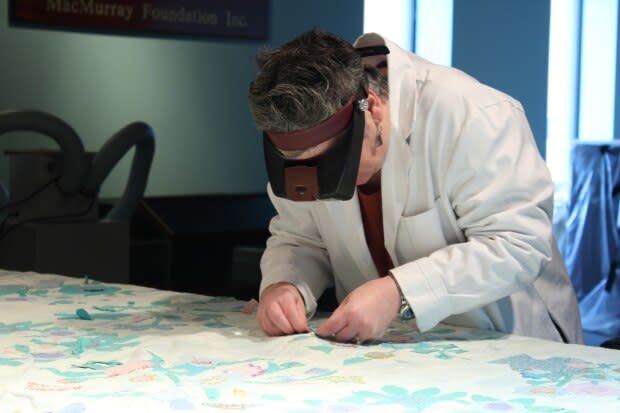N.B. Museum conservator balances protection of collection against need for public display
Dee Stubbs-Lee says she was born to be a conservator at the New Brunswick Museum.
"I've always been a museum nerd," she said, adding she always imagined being able to work with the collections at the Saint John facility when she was a young girl.
Stubbs-Lee worked to make her goal a reality and has been a conservator at the museum for over 20 years.
In her role, she has to work to find a balance between wanting to protect the artifacts in the museum's collection and having them on display for the public to see.
"The big challenge in museum work is … I alway consider it a bit of a teeter-totter, where if we increase public access to material, if we have them out on exhibit longer, if we loan them to other museums, if we allow people to handle them, all of those sort of things that allow access are putting the object at further risk."
"My job is to keep the collection in as good condition as a I can for as long as I can into the future."
Finding a balance
Stubbs-Lee said finding that balance is different for each object.
"For example issues we would have with a metal object are not the same issues we would have with necessarily an organic item, something like a textile or basketry."
There are a number of things that can cause an artifact in the museum's collection to deteriorate, including light, temperature, humidity, pests, physical damage from handling, theft and vandalism.
"We have some challenges with our facility, something that is a well-known issue," Stubbs-Lee said.
Stubbs-Lee said while no item is beyond conserving, the resources they need to do it are not always available at the museum.
"A lot of my job is not specifically treatment, which is what we do to clean or repair items that have gone wrong, but to take that front end action to prevent damage from happening to begin with. That's what we call preventive conservation in our field."

While Stubbs-Lee did most of her training in larger centres and worked with others she could ask for advice and opinions, she said her return to work in Saint John meant she was the only conservator on staff.
"Suddenly I was the expert. I couldn't go ask the expert down the hall, I was kind of it."
Memorable work
As a result, Stubbs-Lee said she developed a good network with conservators across Canada and around the world.
While Stubbs-Lee said all the artifacts in the museum are interesting, some of the more memorable ones include a dugout canoe that has been on display for three years.
The First Nations canoe made from a single log was found on a beach after a storm uncovered part of it.

Through a series of events, Stubbs-Lee said the water-logged canoe ended up in her care for treatment.
"When something is wet when it's organic you can't simply let it dry out. It's not going to keep the same shape. It will rot and twist and crack and deform."
Stubbs-Lee said the canoe was impregnated with chemicals and dried in a slow controlled way.
"I think that was a year of active treatment in a chemical solution and several years of air drying in a controlled way."
Stubbs-Lee said experts in tree ring dating at Mount Allison University helped determine the tree was felled in 1557.
"Not only does that make it the oldest known water craft on the eastern seaboard to my knowledge but, in addition, it confirms that it's First Nations origin whereas before we were thinking it could perhaps be European."
Reviving collection piece

Another favourite piece is a Chinese bridal crown that came into the museum's collection more than 100 years ago.
"This is a crown that would be worn by a bride during a wedding ceremony and it was dirty and crushed and misshapen and all kinds of fancy inlay and bits of kingfisher feathers were popping off."
Stubbs-Lee spent a lot of time working on the piece to reshape it and glue the pieces back on. "I had to come up with clamping because all these little pieces of inlay were mounted on little springs that were getting quite brittle with age."
The end result was successful and allowed Stubbs-Lee to present a conference poster about it in Hong Kong in 2014.
The conservator admits she feels a sense of ownership of the pieces she spends hours working to restore and sometimes has a different opinion on how, or if, they should be displayed.
Stubbs-Lee is now working on a semi-fossilized walrus skull found by fishermen a year ago. Based on others in the museum's collection, the skull is believed to be about 10,000 years old.
Stubbs-Lee said it's a long process to dry the skull out and it's expected to take at least another year to finish.
When asked if people tell her she has a cool job, the conservator said it has happened.
"In many ways I think I'm extremely lucky. I have the coolest job in the world and I work with one of the greatest collections in the country."


